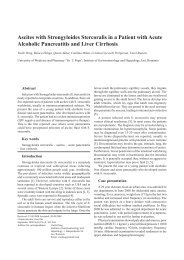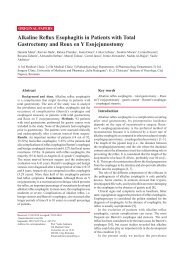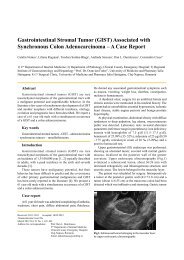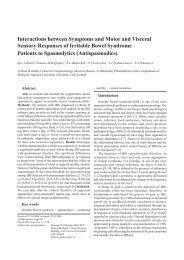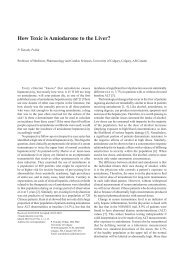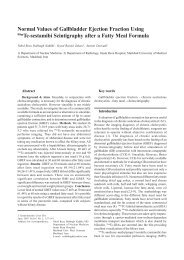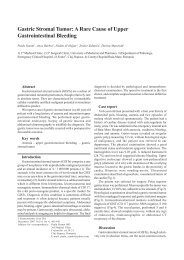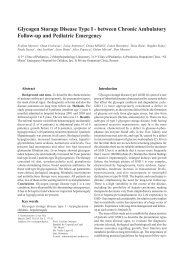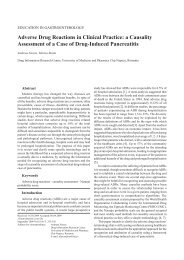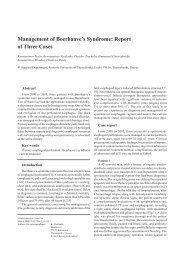Contents - Journal of Gastrointestinal and Liver Diseases
Contents - Journal of Gastrointestinal and Liver Diseases
Contents - Journal of Gastrointestinal and Liver Diseases
Create successful ePaper yourself
Turn your PDF publications into a flip-book with our unique Google optimized e-Paper software.
Analysis <strong>of</strong> the Common Vasoactive Intestinal Peptide Receptor 1<br />
Polymorphism in Gallstone Patients<br />
Marcin Krawczyk 1 , Monica Rusticeanu 1 , Frank Grünhage 1 , Miriam Mahler 1 , Piero Portincasa 2 , Monica Acalovschi 3 , Frank<br />
Lammert 1<br />
1) Department <strong>of</strong> Medicine II, Saarl<strong>and</strong> University Hospital, Saarl<strong>and</strong> University, Homburg, Germany; 2) Clinica<br />
Medica “Augusto Murri”, Department <strong>of</strong> Internal <strong>and</strong> Public Medicine, University Medical School, Bari, Italy; 3)<br />
Department <strong>of</strong> Medicine III, Iuliu Hatieganu University <strong>of</strong> Medicine <strong>and</strong> Pharmacy, Cluj-Napoca, Romania<br />
Abstract<br />
Background <strong>and</strong> aim: Cholesterol gallstone disease is caused by both genetic <strong>and</strong> environmental factors (e.g., deranged<br />
motility <strong>of</strong> the gallbladder wall). Recently, a single nucleotide polymorphism (SNP) <strong>of</strong> the vasoactive intestinal peptide receptor 1<br />
(VIPR1) gene has been linked to late onset <strong>of</strong> achalasia, a lower esophagus dysmotility disorder. As VIPR1 is expressed in the<br />
gallbladder wall as well, <strong>and</strong> patients with achalasia exhibit extraesophageal motility disorders, the influence <strong>of</strong> VIPR1 SNP on<br />
cholelithiasis was investigated. Methods: We analyzed 254 gallstone-free controls (confirmed by ultrasound, age 21-78 years,<br />
88% women, BMI 16-43 kg/m 2 ) <strong>and</strong> 226 individuals from 107 families with gallstones (age 24-80 years, 87% women, BMI 17-55<br />
kg/m 2 ). All individuals were genotyped for the VIPR1 rs437876 SNP (intron 4) with PCR-based 5’-nuclease <strong>and</strong> fluorescence<br />
detection assays (TaqMan). We performed nonparametric linkage (NPL) analysis in affected sib-pairs (ASP), association tests,<br />
<strong>and</strong> regression analyses. Results: Controls were significantly younger (P < 0.01) <strong>and</strong> leaner than ASP <strong>and</strong> cases (P < 0.01), <strong>and</strong><br />
both age as well as BMI significantly increased the risk <strong>of</strong> developing gallstones (P < 0.001). Allele frequencies were in line with<br />
database entries <strong>and</strong> no deviation from Hardy-Weinberg equilibrium was detected. Neither allele <strong>and</strong> genotype distributions nor<br />
NPL scores or the restriction <strong>of</strong> analysis to individuals older than 50 years provided evidence for association or linkage <strong>of</strong> the<br />
VIPR1 SNP <strong>and</strong> cholelithiasis. Conclusion: The VIPR1 polymorphism, previously linked to gastrointestinal dysmotility<br />
disorders, does not represent a common risk factor for gallstones in the general or in an elderly population.<br />
Key words<br />
Achalasia - cholelithiasis - gallbladder motility - single nucleotide polymorphism.



